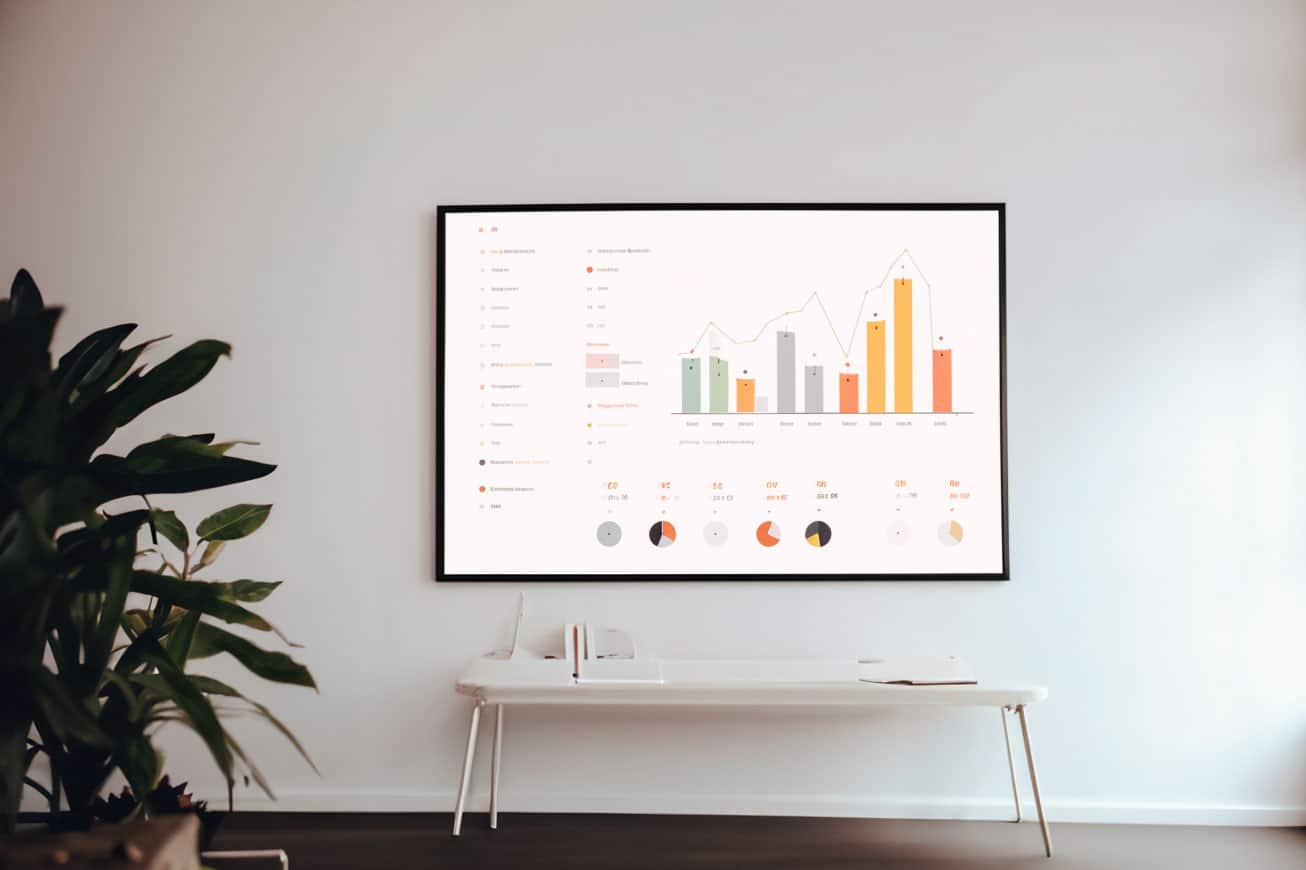No one likes a boring marketing report, if it is unintelligible and unactionable, it is a waste of time to the reader. But how do we avoid this in our writing? We know that writing marketing reports can be a challenging task, particularly when it’s unclear what the readers anticipate. Being actively involved in an internal marketing function or client account often requires immersing ourselves in detailed metrics and a lot of activity, which could potentially overwhelm stakeholders or clients if we were to present everything as-is. We need clarity of purpose and a structure that supports it.
With this goal in mind, I’ve shared a reporting workflow that I like to use across all marketing channels. It’s important to clarify here though that my focus is purely on the structure and writing in this article. I won’t be discussing the presentation aspect of reporting – which is very important. Data visualisation is a whole other subject that warrants its own blog post, and it’s something you should keep in mind as you create your reports.
By focusing on the task of writing it forces you to consider the narrative first, which I find is ultimately the most important discipline of report writing. Relying on dashboards to tell a story is just not going to cut it. Of course, the principles outlined below can be tailored to your specific reporting area so feel free to tweak for your own needs.
I like to divide the commentary in my reports into four key sections, each one informing the next section:
- Activity – What have you done in the period toward achieving your goals?
- Results – What are the results for the period as they relate to your business objectives?
- Insight – Why did you get the results you got? Is there anything you’ve learnt that you can action in the next period?
- Planned Actions/Recommendations – The previous sections feed into ‘what’s next’, what are the priority activities for next period?
I’ve also put some example marketing reports at the bottom for those of you that need to see it in practise (I know I do!).
Activity
I recommend beginning your commentary by providing an overall summary of marketing activity for the period you’re reporting on. Beginning here is essential because it situates the marketing report within the context of the actions during the period and how they tie into the results your reader is seeking to learn about. Here are a few suggestions to simplify this aspect of the commentary:
- Maintain a record of each action you take during the period as it happens, using a tool like ClickUp, Monday or Asana. This way, you can compile these actions at the end of the reporting period, providing a structure for your talking points for the month.
- Ensure that your activities section addresses the last report’s agreed action points, including the ones you didn’t get to action.
- Maintain a positive and enthusiastic tone in your writing, highlighting how these activities have improved overall performance where appropriate.
- Don’t forget to include client activity or if it’s internal, other departments/stakeholders, explaining how you’ve integrated their actions into your work. This highlights the importance of partnership in achieving business goals.
- Avoid sharing vague assumptions of what the activities will potentially do in the future. Keep it factual, the results and insights will ground their relevance later in your marketing report.
Results
When writing the Results section I like to keep to the key performance indicators that relate to the marketing funnel, rather than reporting all the metrics that come to mind. I’m using the commonly recognised AIDA (Awareness, Interest, Desire, Action) breakdown in this article but you can use any variation that best suits your business’ customer journey. By tracking key metrics at each stage of the funnel, we can gain valuable insights into the effectiveness of marketing efforts over time and optimise strategies accordingly.
This section of the marketing report needs to provide concise and relevant metrics that are associated with your business objectives, within the AIDA structure, avoiding unnecessary repetition of information from existing dashboards that might cover the granular metrics associated with your marketing activity. The focus should ideally be on highlighting the key metrics that align with each funnel stage, providing a clear understanding of the performance indicators associated with each stage. Remember, you can always point to other reports/appendices/dashboards if they want more detail.
Let’s explore the key metric types commonly used for each stage of the marketing funnel, starting with Awareness.
- Awareness
This is focusing on the visibility of your marketing efforts and gaining attention in your target market/s.- Brand Visibility
Measure the reach and impressions of your brand across various channels, such as social media and search ads. SERP presence can be measured for SEO. - Brand Mentions
Brand mentions can be tracked through social listening tools and digital analytics (SERP analysis or cross-web tracking), offering a measurable way to gauge brand awareness and understand the sentiment towards your brand.
- Brand Visibility
- Interest
This focuses on how well you are developing curiosity amongst your audience.- Website Traffic
Monitor the number of unique visitors and sessions on your website to assess the level of generated interest. - Click-Through Rate (CTR)
Calculate the percentage of users who clicked on your ads or links to evaluate engagement.
- Website Traffic
- Desire
This focus on this area of the funnel will be measuring metrics that are indicators of desire, they are usually focused on engagement or presale behaviour.- Traffic Quality
Analyse the source of website traffic to determine the level of intent and engagement, such as organic search or referral. - Time on Page/Engagement
Measure the average time visitors spend engaging with your media/landing page to gauge their interest and engagement.
- Traffic Quality
- Action
This section highlights the performance of key actions your audience have taken in response to your activity.- Conversion Rate
Track the percentage of website visitors who complete the desired action, such as making a purchase or submitting a lead form. - Sales/Leads
Measure the number of completed transactions or qualified leads generated from your marketing efforts.
- Conversion Rate
Insights
The cornerstone of any marketing reporting is the insights section, this is where we transform results data into a cohesive narrative. This section should form the bridge between past activities, current results, and future actions, grounded in both quantitative and qualitative data. An effective insights section will offer more than just data analysis. It will provide focus on the data that matters most and provides a catalyst for actionable steps to further business goals.
The power of really good insights lies in their specificity and measurability. Each insight should identify particular contributing factors and suggest specific steps for improvement. Coupled with relevant metrics, this ensures their impact can be tracked and your strategies can adjust over time.
Finally, at the heart of insights there should be clarity. The narrative must offer unambiguous explanations, leaving no room for confusion regarding the insights or subsequent actions. I’ve found through trial and error that if I’ve poorly communicated a valuable insight by being too vague, it will be ignored or dismissed as vague or unactionable. Don’t let that happen in your marketing report, especially if the insight offers real potential for upside.
Ensure it has a clear narrative, grounded in real customer behaviour, which means it needs to be supported by data and clearly actionable next steps. Remember that the aim is to get to the ‘why’ and the ‘what next’ by shedding light on underlying causes, future implications, and the best path forward for your marketing goals.
Planned Actions
I’ve found that insights by their nature will always have a shelf life, each with varying expirations (from weeks to years) depending on the quality and depth of insight discovered. This means that follow through on insight generation is critical to maintaining momentum toward your goals and success. The planned actions section of your marketing report requires a concise list of action points that provide specificity and timeframes.
To provide even greater impact, the Planned Actions section can also provide further detail on how these actions align with broader business goals, reinforcing their relevance and value. You might look to implement a system of tracking and evaluation to ensure the effectiveness of the actions taken, thereby creating a feedback loop that will lead to continuous improvement in the overall strategy (eg. benchmarks, KPIs and/or OKR grading).
In this way, the ‘Planned Actions’ section will effectively translate your insights into practical, timely, and measurable steps that drive the achievement of aligned business objectives.
Concluding Thoughts
It’s true that writing marketing reports can feel like a chore, but when done effectively, it can be a genuinely rewarding experience. It provides the opportunity to hone your understanding of how your efforts have contributed to results and lead into meaningful next steps, while always aligning these steps with business objectives. A thoughtfully produced marketing report allows you to really lift the quality of engagement with stakeholders by sharpening conversations around the results and subsequent prioritisation of action. You’ll also learn something along the way!
I have provided two hypothetical example reports below to illustrate how this approach could be implemented across paid ads and SEO. I hope you find this helpful for your own marketing reports!
Examples for Your Marketing Reports
Paid Ads Report
Monthly Paid Ads Marketing Report: May 2023
- Activity
In May, we developed 3 specific search and P-Max campaigns for XTech’s smartphone range on Google Ads. This involved the identification and integration of 150 long-tail keywords and the development of 40 unique ad assets. We segmented audience lists, designed and tested two customised landing pages, and implemented dynamic bid strategies. We were unable to complete the feed optimisation task mentioned in the last report’s action items as we are awaiting a product data update from the buying department. A critical activity involved collaborating with a strategic partner on a special promotional offer, which was integrated into our campaigns to drive engagement and conversions.
- Results
Our Google Ads campaigns for May had a significant impact on the marketing funnel:- Awareness
We successfully generated 1.8 million impressions, creating substantial visibility for XTech’s smartphone range, a 5% increase from the previous month. This was 3% over our goal target for the period. - Interest
A click-through rate (CTR) of 1.7% was achieved, 6% above last month, translating to around 30,600 prospects showing interest and clicking on our ads. This was 4% over our goal target for the period. - Desire
These clicks led to 24,500 website visits, indicating a high level of desire and consideration for XTech’s products directly attributed to our campaigns, a 5.5% increase month on month. This was 6% over our goal target for the period. - Action
We achieved a conversion rate of 5.5%, which means 1,345 prospects took action by purchasing a smartphone, a 12% increase from the previous month. This was 10% over our goal target for the period.
- Awareness
- Insight
The data suggests that search campaigns using long-tail keywords outperformed display campaigns. This indicates a potential opportunity to enhance performance by allocating more budget towards expanding the long-tail keyword list in future search campaigns. Ads containing the client-approved promotional offer successfully boosted engagement by 25%. This trend suggests that focusing future efforts on creating similar or even more compelling promotional offers could lead to increased sales activation.
Interestingly, while long-tail keywords made up only 30% of our keyword list, they accounted for 60% of conversions, and reduced the cost-per-click (CPC) by 20%. To capitalise on this efficiency, we see an opportunity to optimise the keyword strategy, focusing more on long-tail keywords. This approach is likely to improve conversion rates further and maintain a more cost-effective CPC.
- Planned Actions for June
Based on the insights gathered, the following specific action points have been identified for the next month, along with the expected improvements against our Objectives and Key Results (OKRs):- Budget Reallocation
- Increase the budget allocated to search campaigns by 10% to improve the conversion rate and aim for a 5% increase in overall sales.
- Keyword Strategy
- Expand the utilisation of long-tail keywords in ad campaigns to increase organic traffic by 15% and aim for a 5% decrease in cost-per-click (CPC).
- Asset Development
- Develop new assets to replace underperforming creatives in the retargeting campaign, aiming for a 10% improvement in click-through rate (CTR) and a 5% increase in conversions.
- Promotional Offers
- Experiment with different promotional offers in our ads to boost engagement and aim for a 3% increase in click-through rate (CTR).
- Client Collaboration
- Collaborate with XTech to develop new promotional offers for upcoming campaigns, with the goal of increasing customer acquisition by 5%.
- Landing Page Optimisation
- Conduct A/B testing on layout, content, and promotional offer variations to increase conversions by 10% throughout the month.
- Dynamic Bidding Strategy
- Monitor and adjust the bid strategy regularly to optimise ad rank and manage CPC effectively, aiming for a 5% reduction in CPC and a 3% increase in ad visibility.
- Performance Monitoring
- Maintain regular tracking and analysis of campaign performance to make data-driven adjustments and aim for a 5% improvement in overall ROI.
- By implementing these action points in June, we expect to see conservative improvements aligned with our Objectives and Key Results, gradually driving us closer to our business goals and ensuring the success of our Google Ads strategy.
- Budget Reallocation
SEO Report
Monthly SEO Marketing Report: May 2023
- Activity
Throughout May, we undertook a number of strategic actions to boost the organic visibility of the smartphone range. We integrated 200 pertinent long-tail keywords into website content, optimised on-page elements such as title tags, meta descriptions, and headers, and improved the site’s structure for better crawlability. We collaborated with XTech to produce a highly engaging, SEO-friendly blog post. Additionally, we continued our backlink-building strategy and successfully secured three valuable backlinks from tech blogs with a Domain Authority (DA) level of 20-30.
- Results
The SEO activities during May had a significant impact on XTech’s marketing funnel:- Awareness
Organic search visibility rose by 15% at 300k impressions overall and a 10% increase for brand impressions at 5.5k. We achieved first-page rankings on Google SERP for 15 additional keywords, thereby broadening awareness for XTech’s smartphone range. This was 10% over our goal target for the period. - Interest
The 22% increase in organic website traffic, which equates to an additional 12,000 visits, signifies heightened interest in the product line. This was 10% over our goal target for the period. - Desire
Organic user engagement improved as evidenced by a 15% increase in average dwell time at 1:34m. This was 3% over our goal target for the period. - Action
Organic traffic contributed to a 10% uplift in smartphone sales, representing 300 extra units sold compared to the previous month. This was 5% over our goal target for the period.
- Awareness
- Insight
The data underscores the effectiveness of our keyword optimisation strategy and content quality in boosting organic visibility and engagement. Considering the positive outcomes, we could further refine our SEO strategies and invest more in content quality to maintain and capitalise on the momentum. The three high-domain-authority (DA) backlinks that we obtained notably improved our keyword rankings. We will continue our effort to secure additional high-DA backlinks in the performing keyword areas, through partnerships or guest posting, could result in a further uplift in our keyword positions.
The co-created blog post with XTech on ‘Emerging Smartphone Technologies in 2023’ emerged as a standout, garnering 25% more views and shares than other pages and sustaining high traffic momentum throughout the month. This indicates its high relevance and appeal to our audience. Building on this success, we could explore additional collaborations with XTech or similar partners and concentrate on creating content around emerging trends to attract and retain a larger audience.
- Planned Actions for June
Based on these insights, we propose the following action points for the next month, with the aim of continuously improving our SEO strategy and achieving greater growth for XTech’s smartphone range, aligned with our Objectives and Key Results (OKRs):- Keyword Expansion
- Identify and integrate an additional 30 relevant long-tail keywords into website content to continue improving organic visibility and increase targeted traffic, contributing to a 10% increase in organic search traffic.
- Monthly Blog Post
- Work with XTech to produce another engaging, SEO-optimised blog post. Building on the success of the previous blog, we will focus on a similar theme that appeals to our audience and aim to increase organic traffic by 10%.
- Leverage High-Performing Content
- Implement a strategy to capitalise on the momentum of the ‘Emerging Smartphone Technologies in 2023’ blog post. This may include producing a follow-up piece, interlinking it with other high-traffic pages, and expanding its promotion on social media to drive additional traffic and engagement, contributing to a 15% increase in overall blog traffic.
- Backlink Strategy
- Aim to secure two high-quality backlinks from tech blogs with a domain authority (DA) of 20-30, enhancing our domain authority, improving keyword rankings, and increasing organic visibility, resulting in a 5% increase in organic search rankings for targeted keywords.
- On-Page SEO
- Conduct a comprehensive review and optimization of on-page elements across the website, focusing specifically on the top 15 high-traffic pages. This includes optimising meta tags, headings, and improving keyword placement to boost organic rankings, leading to a 10% increase in organic traffic for those pages.
- Site Structure Improvement
- Enhance site navigation and internal linking for at least 5 key product pages to improve crawlability, user experience, and facilitate better indexing by search engines, contributing to a 5% increase in average time on page for those pages.
- SEO Performance Monitoring
- Continually track and analyse SEO performance using tools such as Google Analytics and SEMRush. Monitor organic traffic, keyword rankings, and other relevant metrics to inform future strategy adjustments and ensure continuous improvement, with the goal of achieving a 5% improvement in overall organic search traffic and a 3% increase in organic conversion rate.
- In June, our goal is to implement these action points, closely monitor SEO performance against our OKRs, and make data-driven adjustments to drive greater growth for XTech’s smartphone range.
- Keyword Expansion







